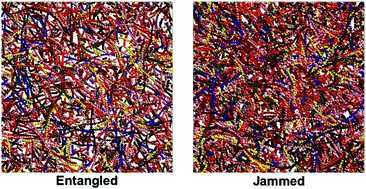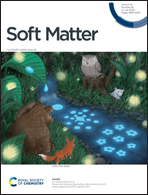Two-stage athermal solidification of semiflexible polymers and fibers
Abstract
We study how solidification of model freely rotating polymers under athermal quasistatic compression varies with their bond angle θ0. All systems undergo two discrete, first-order-like transitions: entanglement at ϕ = ϕE(θ0) followed by jamming at ϕ = ϕJ(θ0) ≃ (4/3 ± 1/12)ϕE(θ0). For ϕ < ϕE(θ0), systems are in a “gas” phase wherein all chains remain free to translate and reorient. For ϕE(θ0) ≤ ϕ ≤ ϕJ(θ0), systems are in a liquid-like phase wherein chains are entangled. In this phase, chains' rigid-body-like motion is blocked, yet they can still locally relax via dihedral rotations, and hence energy and pressure remain extremely small. The ability of dihedral relaxation mechanisms to accommodate further compression becomes exhausted, and systems rigidify, at ϕJ(θ0). At and slightly above ϕJ, the bulk moduli increase linearly with the pressure P rather than jumping discontinuously, indicating these systems solidify via rigidity percolation. The character of the energy and pressure increases above ϕJ(θ0) can be characterized via chains' effective aspect ratio αeff. Large-αeff (small-θ0) systems' jamming is bending-dominated and is similar to that observed in systems composed of straight fibers. Small-αeff (large-θ0) systems' jamming is dominated by the degree to which individual chains' dihedrals can collapse into compact, tetrahedron-like structures. For intermediate θ0, chains remain in highly disordered globule-like configurations throughout the compression process; jamming occurs when entangled globules can no longer even locally relax away from one another.



 Please wait while we load your content...
Please wait while we load your content...